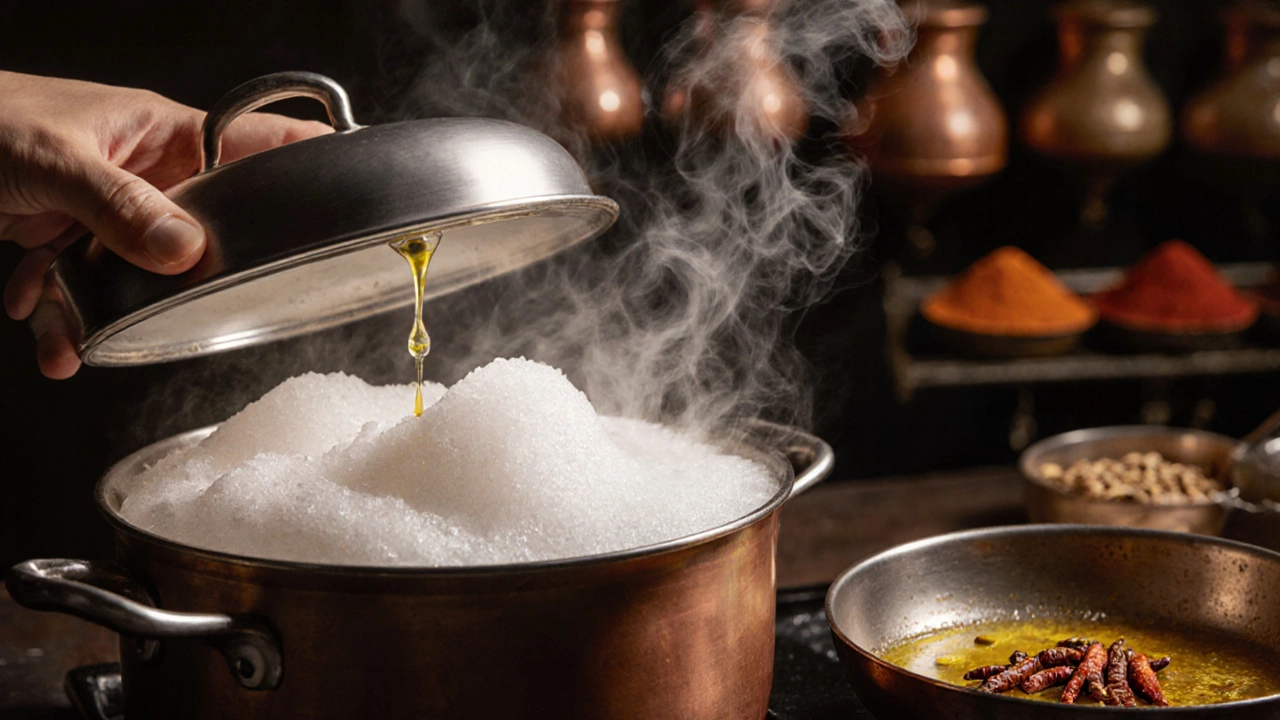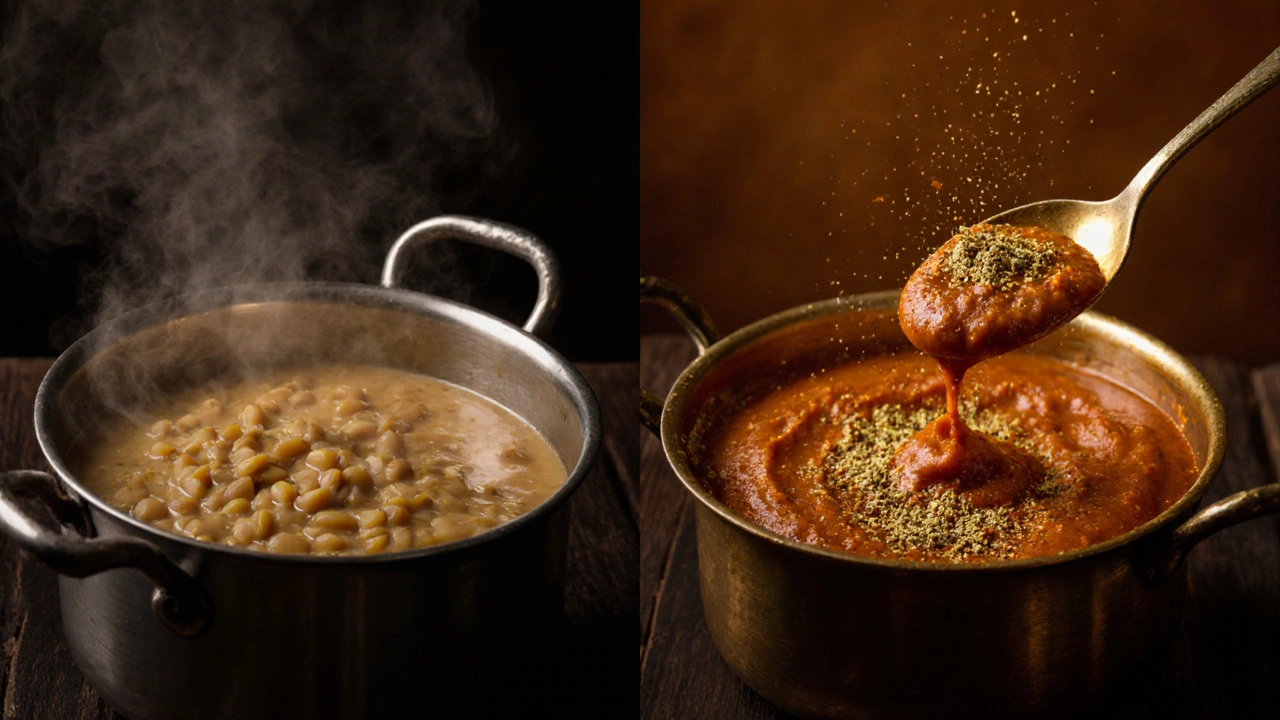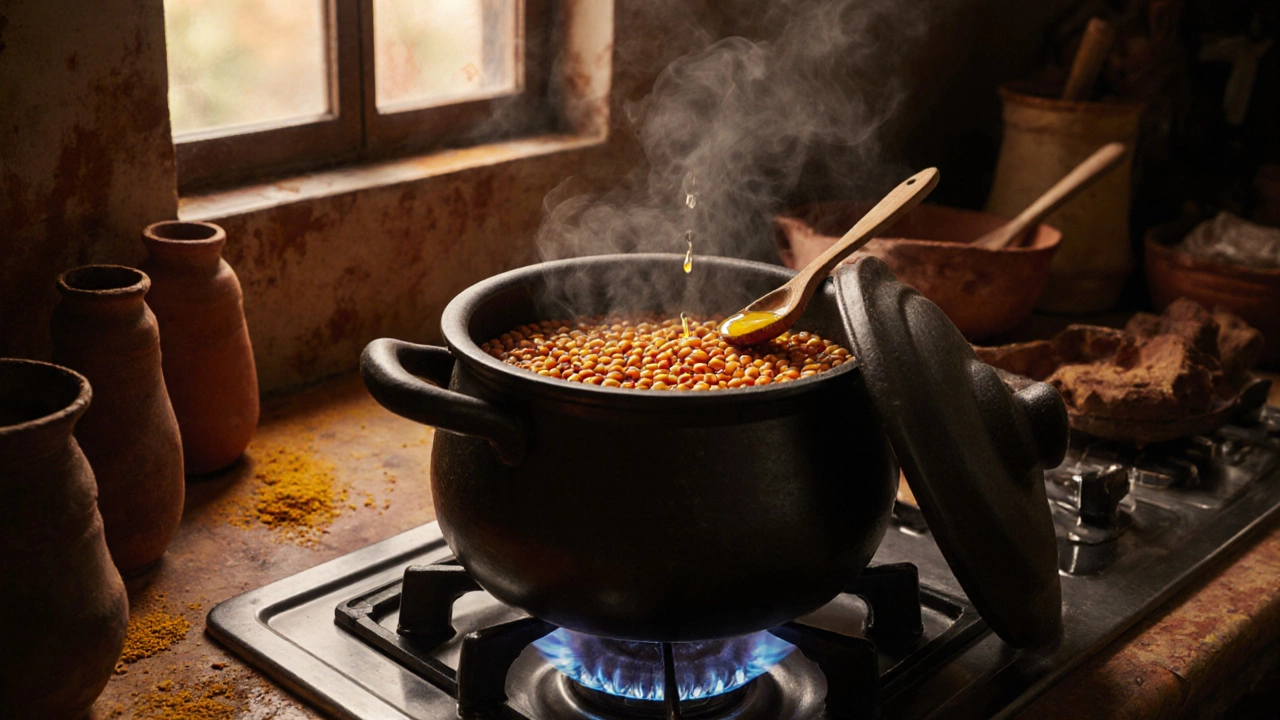Dal Cooking Guide Calculator
Get Your Perfect Dal Cooking Method
Select your dal type and preferred texture to get personalized instructions.
Ever made dal and ended up with either mushy lentils or a pot that boiled over? You’re not alone. The question do you cover dal when cooking comes up in kitchens from Delhi to Sydney - and the answer isn’t as simple as yes or no. It depends on what kind of dal you’re using, what texture you want, and how much time you have. Let’s cut through the noise and give you a clear, no-fluff guide that actually works.
Why Covering Dal Matters
Dal isn’t just lentils in water. It’s a balance of water, heat, and time. When you cover the pot, you trap steam. That raises the internal temperature slightly and speeds up cooking. But it also increases the risk of boiling over - especially with red lentils (masoor dal) or yellow split peas (chana dal), which foam up fast.
Uncovered, the water evaporates slower. You get more control. The dal thickens naturally as the liquid reduces. That’s why most traditional Indian cooks start covered, then uncover toward the end. It’s not tradition for tradition’s sake - it’s physics.
Start Covered, Finish Uncovered
Here’s the method that works every time:
- Rinse your dal under cold water until the water runs clear. This removes dust and reduces foaming.
- Add dal to a pot with 3 cups of water for every 1 cup of dal. Add a pinch of turmeric and a teaspoon of oil or ghee - this helps prevent foam.
- Bring to a boil, then immediately cover with a lid slightly ajar. Let it simmer on low for 20-25 minutes.
- After 20 minutes, remove the lid. Let it cook uncovered for another 5-10 minutes until it thickens to your liking.
- Temper with mustard seeds, cumin, dried chilies, and garlic in hot oil. Pour over the dal. Stir. Done.
This method gives you creamy dal without the mess. No overflow. No scorching. Just smooth, rich lentils.
Which Dals Need Covering?
Not all dals behave the same. Here’s what you need to know:
| Dal Type | Cooking Time | Covered? | Texture Goal |
|---|---|---|---|
| Red Lentils (Masoor Dal) | 15-20 mins | Start covered, uncover last 5 mins | Smooth, creamy |
| Yellow Split Peas (Chana Dal) | 25-30 mins | Start covered, uncover last 10 mins | Soft, slightly grainy |
| Black Lentils (Urad Dal) | 30-40 mins | Always cover | Very soft, almost paste-like |
| Green Moong Dal | 20-25 mins | Start covered, uncover last 5 mins | Light, fluffy |
| Toor Dal (Pigeon Peas) | 35-45 mins | Start covered, uncover last 10 mins | Whole, slightly firm |
Notice a pattern? Smaller, thinner lentils like masoor need less time and benefit from a quick uncovered finish. Larger, tougher dals like toor need longer cooking and more steam to soften properly. And urad dal? It’s so soft it turns into a paste - so you keep it covered the whole time.

Why Foam Happens (And How to Stop It)
That foamy scum on top? It’s starch and protein released as the lentils break down. It’s harmless, but it looks gross and can boil over if you’re not careful.
Three tricks to keep it under control:
- Add a teaspoon of oil or ghee before boiling - it breaks the surface tension.
- Stir once or twice in the first 5 minutes - don’t walk away.
- Use a heavy-bottomed pot. Thin pots heat unevenly and cause sudden boiling.
And if you forget and it starts to boil over? Turn off the heat for 30 seconds. The foam will collapse. Then turn it back on low. Easy fix.
Water Ratio: The Silent Killer of Dal
Most people use too much water. They think, “Better safe than sorry,” and end up with watery dal that never thickens.
Stick to this rule: 1 cup dal to 3 cups water for most dals. For softer results (like in North Indian dal makhani), go up to 4 cups. For thicker, more concentrated dal (like South Indian sambar), stick to 2.5 cups.
And never add cold water mid-cook. It shocks the lentils and stops them from softening. If it’s too thick, add hot water - or better yet, stir in a splash of warm broth.
When to Skip Covering Altogether
There’s one time you might want to cook dal uncovered from the start: if you’re making a dal for a quick weeknight meal and you want it to reduce fast. Some people prefer the deeper flavor that comes from evaporation.
But here’s the catch: you’ll need to stir more often, and you’ll need to watch it like a hawk. If you’re multitasking - answering emails, helping kids with homework, or checking on the rice - go with the covered method. It’s forgiving.

Pro Tip: Taste Before You Serve
Don’t rely on the clock. Taste your dal at 20 minutes. If the lentils still have a bite, keep cooking. If they’re falling apart but still hold shape? Perfect. Dal should be tender, not crunchy, but not mushy either. Think of it like pasta - al dente, but for lentils.
And always season at the end. Salt too early can toughen the lentils. Add it in the last 5 minutes, or even after tempering.
What Happens If You Get It Wrong?
Overcooked dal? It’s still edible. Turn it into a soup. Add a little more water, stir in chopped spinach or tomatoes, and call it dal khichdi. Undercooked? Keep simmering. Add a pinch of baking soda if you’re in a rush - it helps soften the lentils faster. But don’t make this a habit. Baking soda changes the flavor and kills nutrients.
Boil-over disaster? Clean the stove. Breathe. Next time, use a bigger pot. Or just keep the lid slightly open from the start.
Final Answer: Do You Cover Dal When Cooking?
Yes - but only at first. Then, uncover it.
That’s the sweet spot. Covered for even heat and speed. Uncovered for thickness and control. It’s not magic. It’s just how lentils work. Once you try this method, you’ll wonder why you ever did it any other way.
Simple dal doesn’t need fancy ingredients. Just clean lentils, clean water, and a little patience. And now, you know exactly how to handle the lid.
Should I soak dal before cooking?
Soaking isn’t required for most dals, but it helps reduce cooking time by 5-10 minutes and makes them easier to digest. If you’re using toor dal or urad dal, soaking for 30 minutes is a good idea. Red lentils and moong dal cook fast enough without soaking. Just rinse them well.
Can I cook dal in a pressure cooker?
Yes, and it’s faster. Use 1 cup dal to 2 cups water. Cook on high pressure for 5-7 minutes for red lentils, 8-10 for toor or urad. Let the pressure release naturally. Then, open the lid and simmer uncovered for 5 minutes to thicken. The flavor won’t be as deep as stovetop, but it’s perfect for busy days.
Why does my dal taste bland?
Most likely, you skipped the tempering (tadka). Dal needs that punch of fried spices - mustard seeds, cumin, dried red chilies, garlic, and a pinch of asafoetida. Heat oil until it shimmers, then add the spices. Let them crackle. Pour it all over the hot dal. That’s where the flavor lives.
Can I make dal without ghee or oil?
Yes, but you’ll lose depth. Oil or ghee carries flavor and helps the spices bloom. Use 1 teaspoon of vegetable oil instead. You can also skip the tempering and add ground spices like cumin or coriander directly to the dal while cooking - but the taste won’t be as rich. The oil isn’t optional for authentic flavor, but it’s optional for survival.
How long does cooked dal last?
Stored in the fridge, dal lasts 4-5 days. It thickens as it cools, so thin it out with a little water or broth when reheating. Freeze it for up to 3 months in portioned containers. Dal freezes better than most curries because it’s mostly water and lentils - no dairy or cream to separate.
